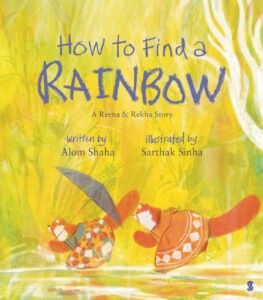
By: Asjad Nazir
BALANCING creativity with his roles as a secondary school science teacher and parent, Alom Shaha was inspired to write his new children’s picture book, How to Find a Rainbow.
The Bangladesh-born British Asian writer, who was raised in London, has crafted a captivating tale set in the Himalayan mountains, blending engaging characters with educational elements.
Eastern Eye had the opportunity to speak to him about his beautifully illustrated book and the significance of featuring south Asian characters in children’s literature.
What initially connected you to creative writing?
I have loved reading since I was a child and books were central to my happiness while growing up. I never thought I could be a writer until quite late in life because I thought creative writing was something only very talented people could do.
I have since realised that, while ‘natural talent’ can provide a substantial advantage, the ability to write creatively is a skill that can be learned and honed [by everybody].
What inspired you to write a children’s book?
I have always loved children’s literature and rediscovered the joy of reading picture books with my own children, now aged five and six. How to Find a Rainbow was inspired by the many books I have read with them.
Tell us about the book.
The story is about two very different sisters who go on a quest to find a rainbow. Along the way, their relationship is tested, but they are ultimately rewarded with the satisfaction of working out the mystery of how a rainbow is formed.
What made you decide to set the book in the Himalayan mountains?
I wanted to write a book with animal characters that were distinctly south Asian, so I chose a location where such animals would live.
Is there a key message you want to convey with this book?
There’s a subtle message that science and art are both creative endeavours stemming from our innate human instinct to make sense of the world and share what we know with others.
Tell us about the illustrations.
I was delighted when Sarthak Sinha, a highly accomplished artist and educator from India, agreed to lend his exceptional talent to the illustrations. His extensive exploration of nature, from tropical rainforests to the high Himalayas, made him the ideal artist for this book.
What, according to you, makes for a great children’s book?
A really compelling storyline with relatable characters.
How important is it to have representation of south Asian characters in children’s books?
There’s lots of research which suggests it’s important for children to see characters like themselves in books and that this may affect their engagement with a story.
One of the reasons why I chose red pandas as my characters, apart from the massive cuteness factor, is that I think books with animals allow children from different backgrounds to identify with them. However, I was also keen for the characters to be distinctly south Asian because I don’t think there are many other picture books out there which have animal characters from this part of the world.
What can we expect next from you?
I’d love to write more stories about Reena and Rekha, the characters in this book. I think they have a whole lot more exploring and learning to do.
What inspires you as a writer?
A lot of my work has been inspired and informed by my work as a science teacher and as a parent.
Why should parents pick up your new book for their children?
How to Find a Rainbow encapsulates positive themes about friendship and creativity that I hope parents will want to share with their children.
I feel the book is also distinct in that, as well as having a captivating storyline and endearing characters, it also features an educational aspect.
Parents can choose to take this further using the free resources available on my website, alomshaha.com.


